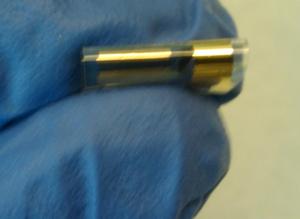Aug 17 2010
A new group of metamaterial structures of a large area, which can be developed on silk substrates was reported by the researchers at the Tufts University School of Engineering and Boston University.
The main features of these substrates include compatibility with the biological environment and also the facility of implantation. The journal Advanced Materials has recently published it online.
 Flexible devices rolled into capsule-like shapes
Flexible devices rolled into capsule-like shapes
Metamaterials refers to those structures that are designed to interact with electromagnetic waves in diverse behavior when compared to the response of atoms of conventional materials. This is due to the existence of resonances at a particular frequency. It is expected that the future metamaterials will find its application in cancer therapy and its optical properties can even make an entity invisible.
Fiorenzo Omenetto, who led the research team, explained about their research, stating that the exact advantages of metamaterials can be realized only by building these materials with predefined electromagnetic response and by a controlled desired frequency.
The team worked on electromagnetic responses of silk metamaterial, which has resonance property at the tetra hertz range of light. Also at this frequency, most of the molecules inside the body express their specific identitities. So tetra hertz frequency can be ideally used for biosensing. With micro fabricated stencils and by using shadow mask evaporation technique, the researchers sprayed gold based metamaterial on the silk films. This is done to make the resulting compound, adaptive enough to be rolled into capsule-like shapes. The size of each sample measured is1 sq cm. Also every sample was found to hold 10,000 metamaterial resonators, each with a specific response to resonance at user defined frequencies.
Another unique property of the silk metamaterial samples is the high degree of sensitivity to the dielectric characteristics of the silk substrate. The interaction between substrate and the environment to which it is exposed to is constantly checked. The ensuing response can be used as an agent for biosensing purposes. Many artificial environment based experiments were carried out by researchers to determine the response of these metamaterials to tetra hertz waves when attached to thin slices of meat. On examining the result, it was found that even after implantation, the resonance property was maintained by these metamaterials.
This technology can be used in the medical world which includes developing an imperceptible concealer around an organ in order to check the tissue behind it, recording the rate at which the desired drug is distributed from a cardiac stent and a lot more applications.